This ulster-style overcoat was made for me by Sartoria Ciardi, the Neapolitan tailor, in 2020. Although I’ve had a few pieces of tailoring from Ciardi in the past five years, this is my only coat from them.
It has proved to be one of my favourites, as much for the material as the style. The material is a heavy wool, the British Warm from Holland & Sherry (9819306), although it’s really the colour that has proved so successful – a taupe that manages to be both classic and interesting, smart and casual.
The ulster style is a common one in Naples (at least going on the number of tailors who offer it by default) and less so among English tailors, who tend towards peak-lapelled DBs. We’ve written in the past here about the different types of coat, if you want a refresher.
The differences are important, because the point of ‘style breakdown’ articles is to compare different tailors’ styles, but the styles of coat in this new series will also vary. As mentioned in the article introducing the series, this will reduce the number of points of direct comparison, but it will also open up the scope of inquiry, and so hopefully make it more interesting in general.
We will start with three ulsters though, from Ciardi, Liverano and Cifonelli, so there direct comparisons will be possible.
House: Sartoria Ciardi
Address: Via Giuseppe Fiorelli 12, Naples
Site: www.sartoriaciardi.com
Cutter: Enzo Ciardi
Price (at time of writing): €5100 (incl VAT)
Suit starting price: €4000 (incl VAT)
The aspect of coat design that most defines an ulster is its gorge line – where the collar and lapel meet.
On a normal double-breasted coat, this would slope upwards and the peaked lapel would be much wider than the collar. On an ulster, the gorge line is horizontal or even slopes downwards, and the lapel and collar are almost the same width.
This makes it easier to wear the collar up, as the points of the lapel are less likely to poke the wearer under the chin. It is possible to make a peak-lapelled coat that works in this manner, but the ulster is easier and is more casual thanks to its patch or postbox pockets. It was originally more of a simple coverall, and still retains some of that feel.
Ulsters vary in how this gorge line is cut. With the Ciardi coat, the gorge slopes very slightly down, is quite closed, and starts quite high on the chest.
We’ll see this more clearly when we have the context of other ulsters in this series, but those three things combine to create a very particular look. The more closed gorge on the Ciardi, for instance, makes it look a little smarter to my eye.
I also know some people prefer the gorge line to be more horizontal, believing it to be more flattering. Personally I see less of a difference there, but I do think that if it slopes downwards, it helps if it starts higher up, as the Ciardi does.
Overall, a good rule of thumb is that anything that points at – and so emphasises – the shoulder is a good thing. Very sloped lines like that of a great coat, do not do this.
As with many of the coats we’ll cover, however, the most interesting area is the back.
A lot of bespoke coats build extra room and fullness into the back, to make it easier to get on and off and to aid movement when worn. This has the knock-on effect of being rather flattering, with all that excess gathered under the belt at the waist, then flaring out in the skirt. It makes your back big and your waist small.
Tailors vary quite a bit in how they deal with this fullness, however. The back can have various different combinations of darts and box pleats (closed at both ends) and also some excess that is simply left to be gathered by the belt.
Given the reputation of Neapolitan tailoring for softness and casualness, you might expect the Ciardi to be quite simple. But it’s actually fairly complicated.
Like a Florentine coat, the Ciardi has one long pleat that runs all the way down the length of the back. But it then has two additional box pleats in the middle, one on either side. Those pleats end in 5cm darts, rather than simply being tacked closed. And the central pleat does not end under the belt, as is more usual, but in line with those lower darts, around the level of the hips.
I should say that in my experience, the various ways of finishing the back don’t make much difference to comfort. The most important thing is how much fullness there is to begin with, and then how long and deep that central pleat is. What’s done either side makes little difference. So we’re largely talking about aesthetic points.
One way in which the Ciardi is quite simple – but still unusual – is the construction of the collar.
The collar is simply one piece of material folded over, where most have some form of insert on the back to give it shape. And there is no dart or cut underneath either.
As with the rest of the style breakdown series, I worked with a tailor to analyse these kinds of technical details, and they highlighted this point. Without either the insert or a cut under the collar, a lot of ironwork is required to shape it.
And that ironwork has to be very precise, as you have to create a curve that perfectly meets the line of the lapel on either side. You need to work it in stages, letting the material dry out between each one to see where it settles.
Elsewhere, the things that give the coat personality are its curved breast pocket, very natural sleevehead, and two lines of stitching around the edges. Like the rest of the finishing, this stitching is good by Neapolitan standards but certainly not as neat as English or North Italian tailors.
There’s also the turnback cuff, which opts to have its seam on the inside rather than the outside of the sleeve. You need to pick one, and most tailors go for the outside, as we shall find in subsequent pieces. The Ciardi way does have the advantage of making the cuff look cleaner, however.
The next coat in this series will be my Liverano Ulster, in a week’s time. For more on the background to this series, including how the measurements below are taken, see the introduction here. The whole Style Breakdown series can be seen here.
Other photos of this coat (including with collar up) here.
Style breakdown
- Shoulder width: 6½ inches
- Shoulder padding: None
- Sleevehead: Natural
- Lapel width: 6 inches (DB ulster, so flat)
- Collar width (at gorge): 3½ inches
- Gorge height: 3 inches
- Outbreast pocket height: 12½ inches (shoulder seam to bottom of pocket welt)
- Buttoning point: 19 inches
- Wrap (distance between waist buttons): 4 inches
- Back length: 46 inches
Other clothes shown:
- Anderson & Sheppard suit in end-on-end grey worsted
- D’Avino shirt in superfine pale-blue poplin
- Drake’s printed silk tie
- Cleverley imitation brogue shoes
- Permanent Style Arran charcoal scarf
- Vintage brown pigskin gloves


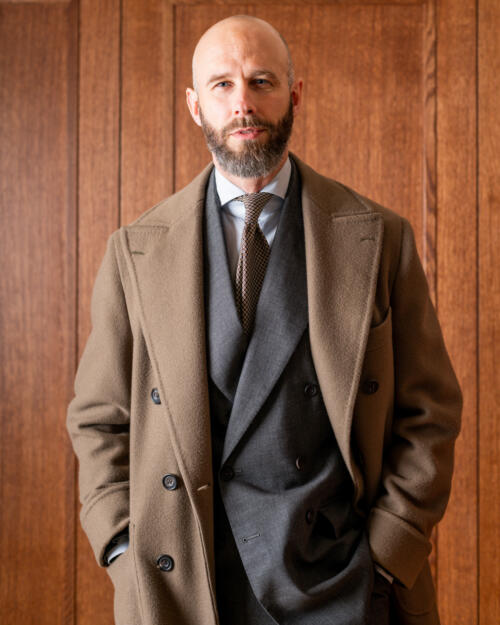
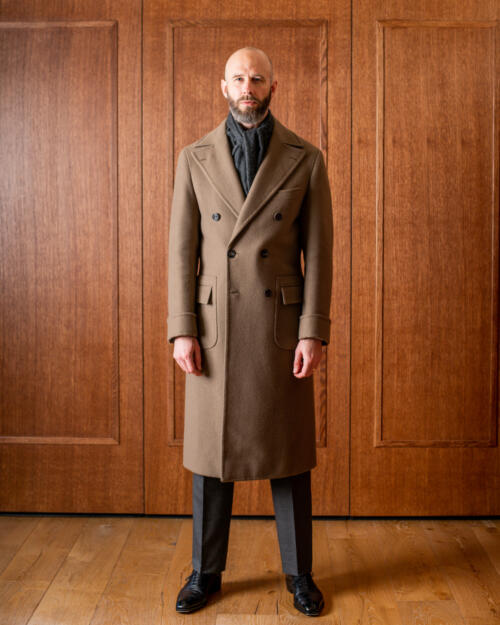
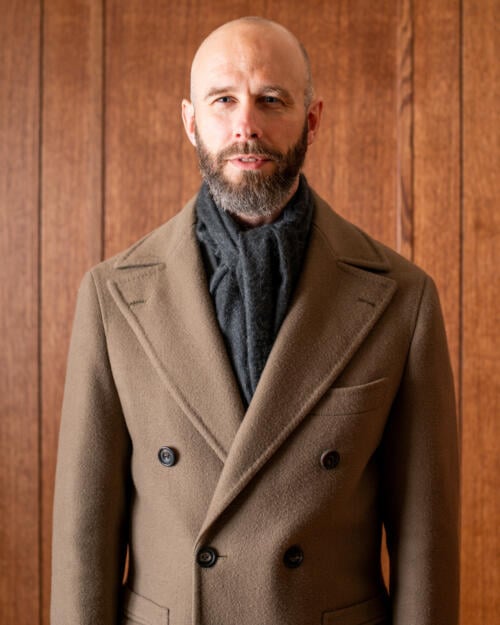
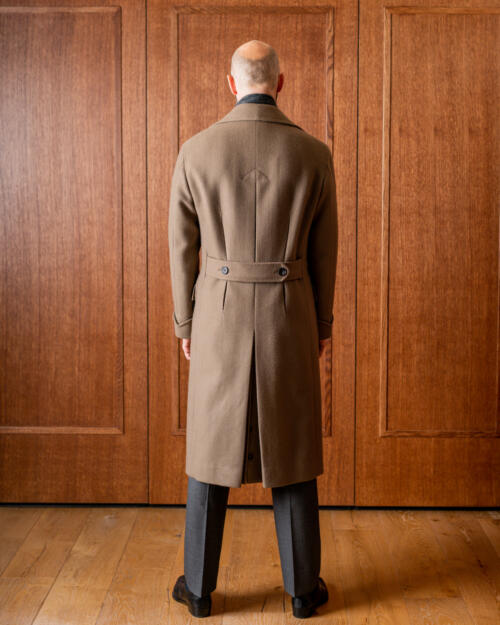
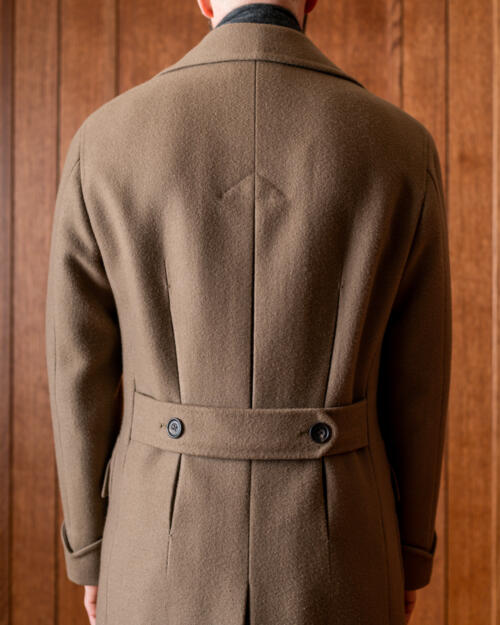
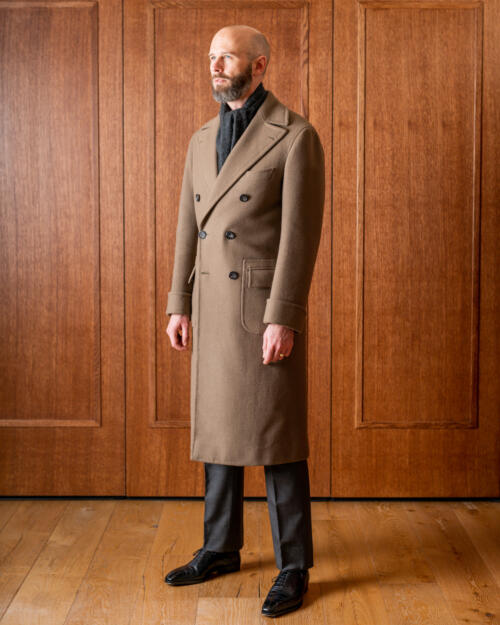
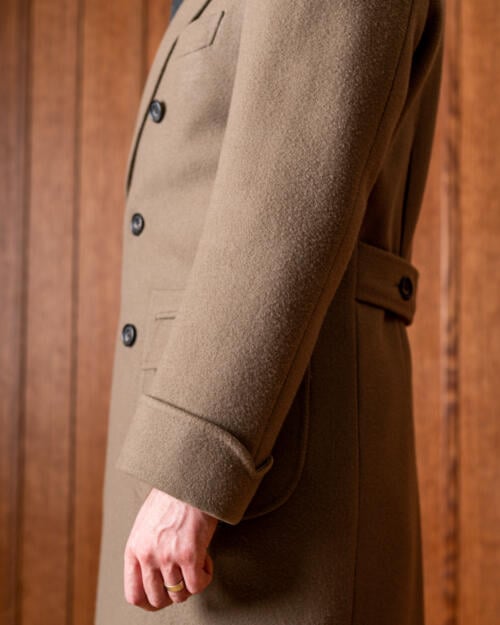
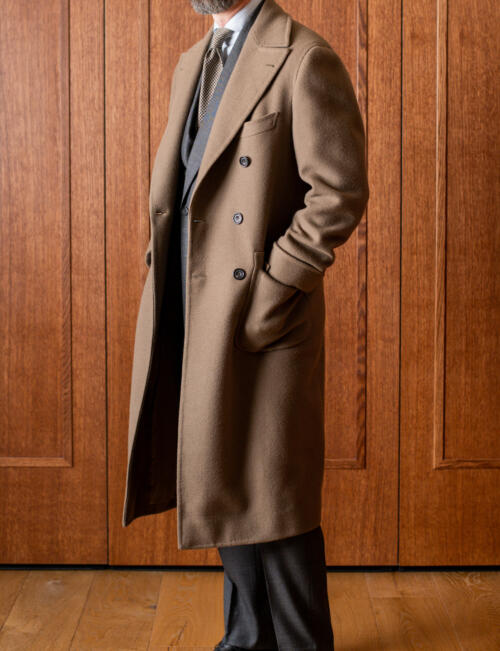
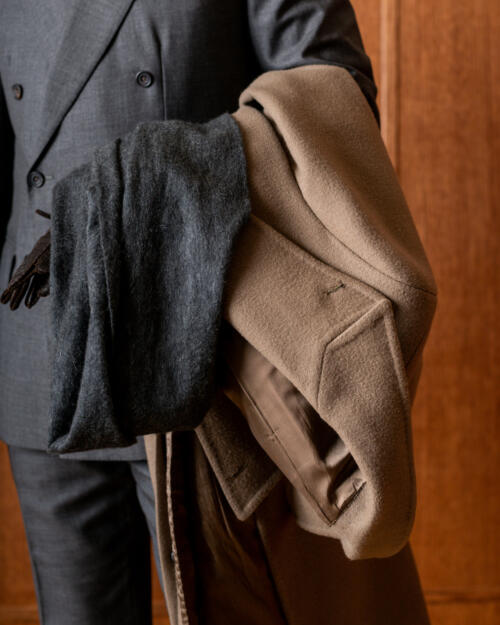


























That’s one cracking coat Simon.
Morning Simon
Lovely coat!
Just for clarity, you refer to this H&S cloth as British Warm. H&S call it British Taupe Solid, which I think is more accurate, as British Warm describes the design and style of a particular type of coat.
I think it’s important not to get descriptions muddled up (albeit pedantry can be taken a bit too far!!).
Hey James,
Absolutely, it’s just that H&S designed the cloth to recreate the material used in that particular type of coat historically. So it’s good to communicate that
Sorry, you’ve confused me now!
If British Warm is a style of coat, how can the name be used to describe a type of cloth?
Thanks
Because that type of cloth was used for that type of coat
It’s a beautiful coat but because coat fit is more forgiving
1 Do you think a similar fit could be achieved by getting a very good quality RTW coat and having that altered ?
2 Or even a MTM coat (although we hear a lot less about MTM coat makers)?
You could get a good fit with both options, but it would never be quite the same as bespoke, mostly in terms of the 3D nature of the way it’s shaped. Still, 99% of people wouldn’t notice any difference
Given the considerable expense that’s interesting to know .
I’m in “in the market” for a coat so would really be interested in MTM options.
More so then a suit it would get considerable more wear .
Be interested to hear others comment on N good MTM coat providers.
Hey Robin,
I’ve really enjoyed this coat by Frank Leder. It is now on sale on No Man Walks Alone as a RTW piece but I got it MTM for around £900 2 years ago. He is contactable via email and got the fit spot on.
The cloth is tweed-like, a very rough German wool, and the fit is rather snug, suitable to wear over knitwear but not a suit.
You could ask if other colours are available.
Personally I would have preferred this coat to have box pleats at the back, but otherwise it has served me perfectly, and I receive positive comments about it not infrequently.
I have personally tried on Drake’s polo coat in the past, and I find this FL coat much sleeker, and gives more of an ‘air’ if that makes sense. The collars are 7.5cm with a discreet latch that allows it to be buttoned in place if worn closed.
I have no affiliation with FL, but I really have enjoyed his creation till this day(I’m wearing it now) and think it’s only right to promote good businesses.
Great looking coat. Saw your previous post and liked it then. Have not purchased from NMWA but their customer service is frequently touted on PS. Apparently they do frequent collaborations with FL. Price point very reasonable for a statement piece. Thanks for lead.
when you say 99% of ppl wouldn’t notice any different do you mean the observer, or the wearer, or both?
Just the observer. The wearer would be much more likely to
Yes, you can. IMO, I would not bother with bespoke or MTO for a coat. And both you and Simon are right. Coat fit is forgiving and no one will know the difference. I just bought a camel hair Ulster with decent heavy fabric from Brooks Brothers. Only thing that needs to be tailored are the sleeves. All for under $1,000.00. There’s also a recent article on here where Simon or one of his guest writers discuss off the rack options which you should read. Good options for coats are mentioned. I just do not think $5500.00 is worth it for a coat as in this case. And that is not including the trip price and duties you have to pay once it is done. I learned my lesson on those other expenses when I got a bespoke jacker made by Sartoria Dalcuore.
Thanks Dan. There shouldn’t be any duties to pay, and taxes are included. But the article mentioned is here. In terms of others noticing, I should say for context that most of the general public probably wouldn’t notice anything nice you’re wearing!
Thanks for the response Simon. I did want to mention that the coat in this article fits and looks great. As for duties, I did have to pay them, and I live in the USA. The carrier DHL was the one who notified me I had duties to pay at customs. Sartoria Dalcuore made it clear it was my responsibility. It was surprising as the duties came out to $750.00. I had to dispute it with US customs because they overvalued the sports coat. In the end, I paid some. I do not know if I will ever get bespoke again due to the additional costs and fees.
Interesting, thanks Dan. And you’re sure that was duties, not taxes?
Yes. I went back and looked at the DHL notice and emails from Sartoria Dalcuore after your questions. DHL paid the custom/duty charges and sought reimbursement from me. Emails from Dalcuore told me I had to pay DHL or the jacket would be returned to them and they would have to charge me costs plus a surcharge. As I said, it is pretty much doubtful I would do bespoke again considering all this hassle. Btw, your questions are making me feel like Dalcuore dropped the ball on this one.
Interesting, thanks Dan. That would certainly be the case with taxes (that you would have to pay DHL etc) but from our experience importing I was surprised at the duties/customs
Hi Simon, what a stunning coat, and clearly Ciardi are a fantastic tailor.
Just a quick query on pricing in the market today. Your Ciardi suit from 2018, where ‘the value is also good, at €2800’ – comparing to the figure you quote in today’s article of a suits starting point of €4000…that’s quite a leap above inflation, would you say that’s similar for most of today’s top tailors?
If I recall my thinking from 5ish years ago, €2800 would indeed represent quite good value for that level of work, however my thoughts today with regards to >€4k, I’m unsure if I could justify it.
I know what you mean John, a lot of costs have gone up in recent years, particularly after COVID, and that includes tailoring. I think also that’s the trunk show price, it might be lower in Naples, and Ciardi have more realised the costs of travelling here regularly. Still, few full bespoke English tailors are making suits for under £3500 today
This is aimed at a key question in classic meanswear, at least for me. As you write, 99% may not realize if a coat is bespoke or MTM or RTW and altered by a capable tailor. But the price differences are huge. What’s more, with a bit of luck and skill, you can buy great RTW coats on sale at the end of winter, which brings the prices down even further. As far as I understand it, however, there are no serious bespoke sales because there is no production in stock, which then has to be emptied before the spring products take the place.
As far as the quality of the work is concerned, I assume that a good RTW or MTM piece is not quite as high as a very good tailor’s but comes close. As far as the fabrics are concerned, I think industrial producers have a huge price advantage because they buy a completely different quantity and have a much higher marketing power. My tailor is always amazed when I bring her a jacket or trousers to alter because she could only buy the exact same fabric for the same price as or even more than my trousers cost.
From a rational point of view, bespoke is therefore difficult to justify, unless you have a specific body type and nothing in RTW or MTM fits. That leaves probably two categories of clients. Those who don’t care about money at all, because it makes no difference to them whether they pay EUR 1000 or EUR 5000 or EUR 10000. That’s why the top bespoke tailors (think Savile Row) will probably never have a problem, because there will always be a sizeable clientele who want the best money can buy (other tailors will probably benefit little from this). And, the second categoriy, people who are very interested in how something is made and that it is made especially for them, so they have a different relationship to the garment than someone who just buys it RTW.
I think the logic makes sense Markus, except there is a point where you realise you’ve been buying decent RTW coats for 10 years, maybe even 20, and they’ve been fine but you only ever need one, and you want one that’s really special, and can last longer for a few reasons, not least the ease of alteration of bespoke and the relationship with the maker.
Some people make that kind of decision when they get a bonus or have a little bit more money for some reason, and they want to get that one thing. It makes less sense to buy something more unusual or extravagant, at least to me. And there’s also some overlap of the last two categories, ie people that have money and who care and understand about the bespoke points.
Of course, all discussed better in this article where we addressed the specific question of whether bespoke is worth it
I just wanted to add that maybe we don’t need to focus too much on the 99%. I would argue that the owner himself will always sense the particularities of a coat/sport coat that is made only to fit him and nobody else. There are differences you cannot unsee once you have tried good bespoke. That of course does not mean that this experience is worth x sum for everybody. We cannot put a price tag on everything. That would be a slippery slope towards cynicism.
I agree Alexander
I would agree, a quick check of prices on Savile Row shows prices are north of £6500 in most cases (inclusive of VAT).
Can I ask you Simon, what made you prefer this heavier, 800-900g weight in these types of coats? From following your guides and classical menswear community in general I always accepted that this is the proper weight for winter coat. These days though I prefer 650-700g more and I live in nordic conditions. I feel that it might have been a good weight at turn of last century but for modern lifestyle, where people tend to not spend a lot of time in cold, lower weight works better, it’s less cumbersome and rigid and also doesn’t overheat you as much when inside.
For example last week I missed a train and had to wait in -20c cold for 40 minutes, having 650g coat, regular wool 2ply rollneck and long sleeve thermal layer under, I managed to avoid getting uncomfortably cold.
People who tend to spend a lot of time doing outside activities in properly cold climates tend to prefer parkas with down filling and in my opinion rightly so as these are just so much more practical. At temperatures where you can literally feel life draining from you, the looks will always be secondary.
I think it’s just from a love of the fabric itself. You appreciate what it is, why it’s lovely, and you certainly can wear it
Absolutely wearable but I do find that I can feel the extra weight on heavier coat and thus reach more often for the lighter ones. I guess it’s also very personal like how some prefer the lightness of titanium watch and others prefer the weight of steel. A good thing to figure out before making a bespoke commission.
True. Depends on lifestyle a little too – eg if it’s something you tend to wear on long walks, or more for commuting etc or wandering around town
A fine piece of tailoring but it looks so old fashioned next to the louche styles – typified by your own PS developments – which are so au courant today.
There is a lot of work in this coat, particularly in the back, which make it look quite militaristic and outdated.
Thanks David. I wouldn’t say that’s necessarily the case if it’s worn with other things, eg how it’s worn here. With a casual combination like that I think it’s just something characterful and interesting
I noted commentary on lower pockets was omitted. Are these fairly standard across makers and therefore do not warrant specific mention?
They are more standard, yes. There are elements we could talk about there, but I wouldn’t say they’re the most interesting
Hi Simon,
Is that PS scarf the dark grey scarf on the shop, or is it a seperate product (seeing it labeled as charcoal)?
Will you also be covering your new Ulster from B&Tailor in this series, or will that be kept for a seperate time?
Considering a trip to Korea, and have thought about asking them to make an Ulster in the same fabric as this british taupe warm. Do you think their style suits a fabric like this?
Yes it is the same.
They will be covered separately.
I think it would well, yes. They’re not that different to Ciardi in terms of the structure
As the collar is shaped by ironing rather than an insert or a cut to give it shape, if you are caught in a torrential downfall would this be likely to ruin the shape of the collar such that it would need expert re-pressing?
No, if it’s done well (as this would be) that’s not going to change
Lovely coat.
And speaking of coats, this is where your coat ends up at the Tate Britain cloakroom these days. In an airport security styled bin!
Madness!
Oh dear…
Simon,
What color gloves would you wear with this overcoat? You seem to show a pair of black gloves in one picture, but is that what you would recommend? Perhaps brown or tan? (Could you suggest a color for gloves in your subsequent reviews of coats. Thanks. )
Thanks,
Jack Williams
Hey Jack,
The series isn’t really on styling, but happy to answer any comments like that in the comments. And those kinds of things have often been picked up in the original articles about the coats.
With this coat you could wear a variety of colours of gloves. For the basics, shoes you like with it are a good place to start. So black and brown and tan shoes are all nice with it, and so all colours of gloves. Then brighter ones are nice too, specifically yellow, eg these ones
One my my favorites of yours. It’s interesting how the colour appears so differently in the various photos you’ve posted over the years, depending on the light.
Very nice coat and love the length. Am I right in thinking it’s just below the top of the calf? covering the “swell” of the latter?
Yes I think that’s fair
Great first piece of the series. Looking forward to more.
I’m looking forward to this series on overcoats as I greatly admire and appreciate them for all the reasons you state.
Several years ago I replied to a comment (on the article about the belted wrap coat) that I’d recommend a British Warm as a versatile “one coat (for winter in Canada)” – and your example here is a perfect demonstration as to why. In reflecting on my own, I see that the less militaristic details make a big difference; mine has epaulettes (adding bulk and squareness to the shoulder), a 6×3 button stance (adding squareness to the body), and a longer length (shortening the legs) – all of which you avoid here. Mine is a Crombie Melton in taupe, which is a hint drab in comparison to how yours appears to be in the photos.
Nevertheless, while not quite as elegant, it’s thick and warm, and straddles the line between formal and casual while being distinctive and (slightly) understated. Then again, when everyone else is wearing black (be it a puffer or topcoat) it’s hard not to stand out a little.
I also have a British warm – crombie Melton in taupe. I picked it up in a charity shop a few years ago for a pittance, requiring no alterations for the fit. I replaced the leather football buttons for matte horn instead, and it’s still one of my most versatile coats. Wouldn’t get rid of it for the world! Like you I agree that it doesn’t have the same elegance as seen here, but it’s a trustworthy workhorse that can get thrown about and can withstand an eastern European winter with ease
It would be very interesting to show us some photos with the same outfits but instead of the ulster the ps single breasted coat. I think the formality difference is not so big to own two coats if you dont work with a suit or blazer day in day out. Something more versatile could sit on both casual and formal and be worn more often too. It makes me also wonder how many of the ps readers are so formal dressed in a daily basis that a 5-6k coat would make sense.
Personally, I avoid wearing a DB overcoat over a DB suit jacket, or a single-breasted overcoat with a single breasted jacket underneath. I find mixing the two more interesting and, of course, not repetitive.
Hi Simon,
I have a question about the suit. I’m looking to have a good, but fairly conventional, navy business suit made. Something sufficiently boring that I can wear it for business occasions that require a suit, but with something subtly interesting to catch the eye. Would having it made with an end-on-end or herringbone fabric make the suit too casual? Any other ideas for giving the suit something interesting, but subtle, to look at without subtracting from its business formality?
Either of those would be fine BC, yes. Just avoid a check or stripe and, if I may say so, try and get the interest in the make and design, rather than material. It’s easy to try and force that a little bit and then find you take against any pattern or texture later. A great suit like this should be an elegant blank slate for your style
Simon, remarkable coat.
I have a camel polo coat from Cordings which obviously varies in more ways than it’s similar to this (and costs a fraction) but the thing that bothers me the most are the pronounced shoulders. Any chance a decent tailer could soften them at all do you reckon?
Thank you.
Best,
IEB
If you mean the width of the shoulders, then no not really – you’d be taking a large part of the coat apart, it would be difficult, expensive and an uncertain outcome.
Reducing the padding on the shoulders would be easier, but it would affect the fit a little
Thank you Simon, the latter, indeed.
May give it a go.
Best
IEB
Hi Simon, it looks like the coat’s shoulder measurement is quite small, same as your Pirozzi jacket. Will you be able to wear the coat over your jacket easily?
There’s always a little compromise there, but yes I find it’s fine.
Hi Simon,
thank you for this interesting breakdown! Wouldbit be possible for you, to also always add the measurements in metric units (cm preferred)?
That would make comparing your measurements for me much easier as I don’t really have an intuition regarding the lenght of an object in inches.
Best regards
Kilia
Hey Kilian,
I’ll try, though it’s a lot of detail to go through already! Of course you can convert yourself as well if you have time
Could you kindly provide information on the camera’s height placement for these shots, and whether it is tilted downward or level? I’ve noticed that selfies I take can sometimes appear quite different depending on how the cameraphone is held, making assessing fit inconsistent and difficult, especially when trying to take pictures of the sides and back…
It’s at waist level, straight